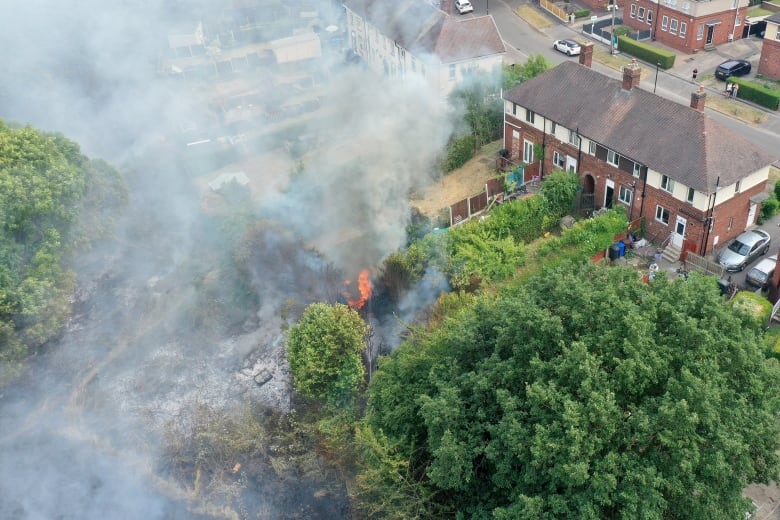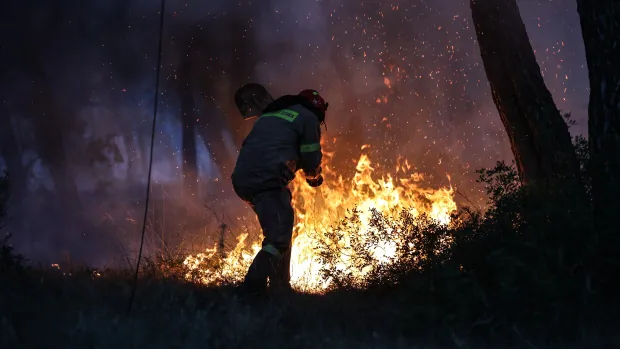The horrifying wildfires afflicting Europe throughout bouts of utmost warmth this summer time are a scourge the world will see extra of sooner or later, scientists say.
That raises questions on what may be finished to mitigate their impression as society grapples with the bigger challenges of attempting to restrict the warming of the planet. Although there are steps to be taken to forestall hurt to people and habitat, the underside line is what we’re seeing in Europe might be a permanent problem.
“What we’re witnessing now’s a preview of the world we’re leaving to our children,” Víctor Resco de Dios, a professor of forestry on the College of Lleida in Spain, advised CBC Information through e mail.
A bleak backdrop
There have been prior warnings that wildfires will change into extra intense and happen extra typically in a long time to come back.
Current experiences from Europe — which has seen practically 1,900 wildfires to this point this yr, nearly 4 occasions the typical from 2006 to 2021 — illustrate the menace such fires already pose.
In southwestern France earlier this week, beachgoers in Arcachon lounged close to the Dune du Pilat, Europe’s tallest sand dune, as smoke from wildfires billowed into the sky. 1000’s have been pressured to go away close by campsites on brief discover.

Two wildfires within the wider Gironde area of France have been reportedly contained by Thursday, although officers stated they would not be totally extinguished for weeks.
In neighbouring Spain, the current spate of wildfires have claimed lives of a firefighter and a sheep farmer. Fires there have pressured hundreds to flee, although some have since returned house.
In Britain, London Mayor Sadiq Khan stated on Tuesday the town’s firefighters had faced their busiest day since the Second World War, on account of fires that broke out throughout the record-breaking warmth wave.
A Forest fireplace burns in Shirley Hills on the outskirts of South London as Britain declares a document for the very best temperature to this point.
Excessive warmth, fierce fires
The recent climate is only one side of why wildfires are plaguing Europe. Excessive winds and drought additionally assist propel fires by forests and to locations the place persons are.
Friederike Otto, a senior lecturer in local weather science at Grantham Institute for Local weather Change at Imperial School London, advised The Related Press a few of these elements are notably acute in southern Europe the place summer time wildfires are successfully “the brand new norm.”
That is to not say the danger goes away because the seasons change.
“The fireplace season is lengthening globally,” stated the College of Lleida’s Resco de Dios, pointing to current fires which have struck Portugal in early July, forward of the brunt of its typical fireplace season later in August.
Resco de Dios stated seasonal fireplace threat relies upon rather a lot on the climate and the way dry the panorama is. And that has implications for future wildfire dangers because the world sees extra frequent episodes of utmost climate.
“The longer the dry spells beneath local weather change, the sooner the hearth season will begin and the longer length it’s going to have,” he stated.

Lethal penalties
On continental Europe’s southwestern edge, Portugal has confronted gruelling temperatures alongside wildfires which have burned by tens of hundreds of hectares of land.
There has additionally been lack of life: A pilot was killed in a crash, whereas preventing a wildfire within the nation’s north and an aged couple died whereas attempting to flee a wildfire in a car, in line with Reuters.

“What is going on in Portugal is tragic,” stated Susan Gardner, the director of the United Nations Atmosphere Programme (UNEP)’s ecosystems division.
And Portugal has beforehand seen the devastation such fires may cause, when dozens of individuals died in wildfires there in 2017.
Prevention efforts
Within the wake of these lethal fires, Portugal applied a extra complete strategy to fireplace administration in a bid to forestall hurt and lack of life, Gardner stated. This concerned extra engagement on the native stage, partly to assist handle the dangers of wildfires in rural areas.
The UNEP has known as for governments to spend twice as a lot on prevention, planning and restoration for wildfire occasions as they do on direct response efforts.
“Then you definately’re really lowering the danger, you are lowering the injury,” stated Gardner.
Resco de Dios sees a have to “take speedy motion to curb the hearth downside” with a deal with the land itself.
“We should make a large-scale transformation of our landscapes in order that they change into tailored to the longer term local weather and fireplace regimes,” he stated, noting this would come with efforts to take away extreme vegetation that may gasoline wildfires.

Dealing with the longer term
Coping with extra intense wildfires could also be daunting, however scientists specific optimism that we are able to make adjustments.
“This isn’t an act of God,” stated Otto, the local weather science lecturer. “That is, to a big diploma, our doing.” However, she stated, people have various energy to do one thing about it.
Otto stated issues we are able to do to adapt embody placing an finish to the burning of fossil fuels and educating individuals about local weather change.
Extra usually, Gardner is optimistic about rising public consciousness of the perils of local weather change, notably amongst younger individuals — and thus the capability to push for wanted adjustments.
She says that yearly individuals change into extra cognizant of “how the selections we make as people contribute to the massive image when it comes to the local weather future that we would like.”


